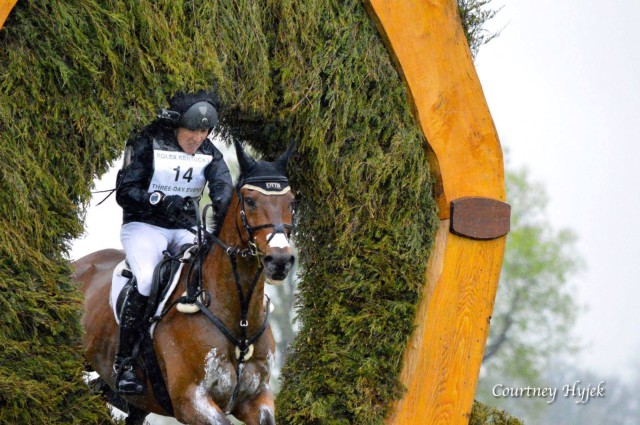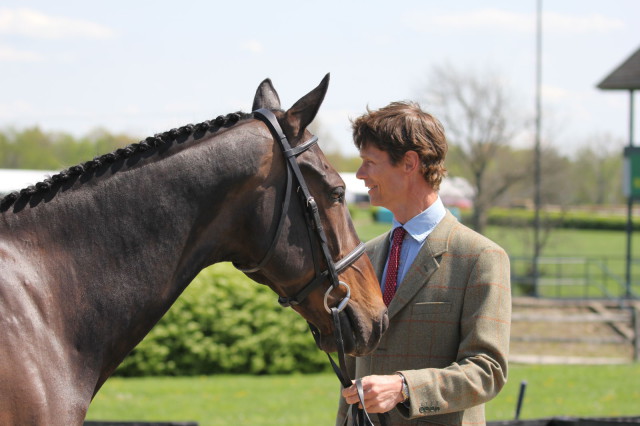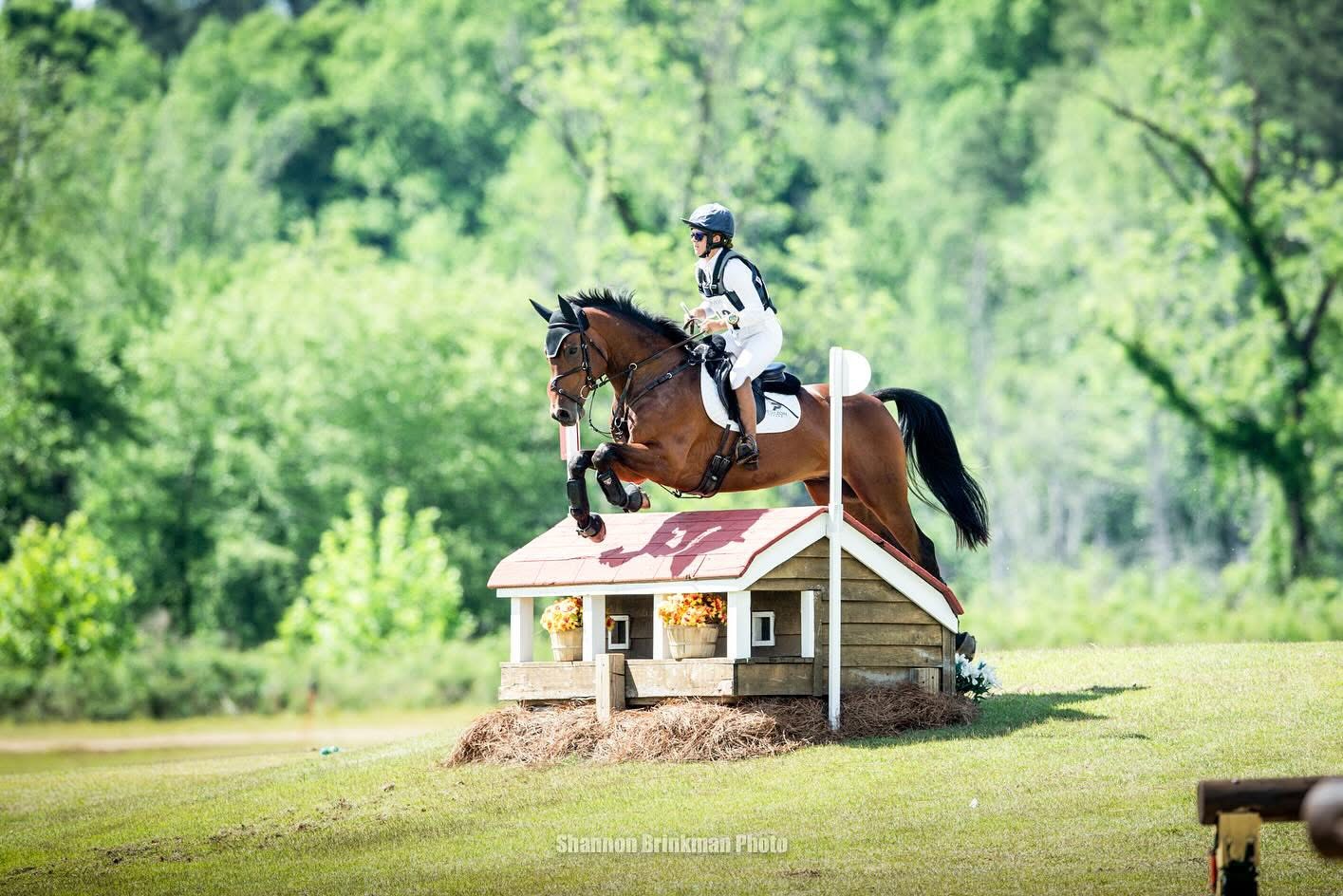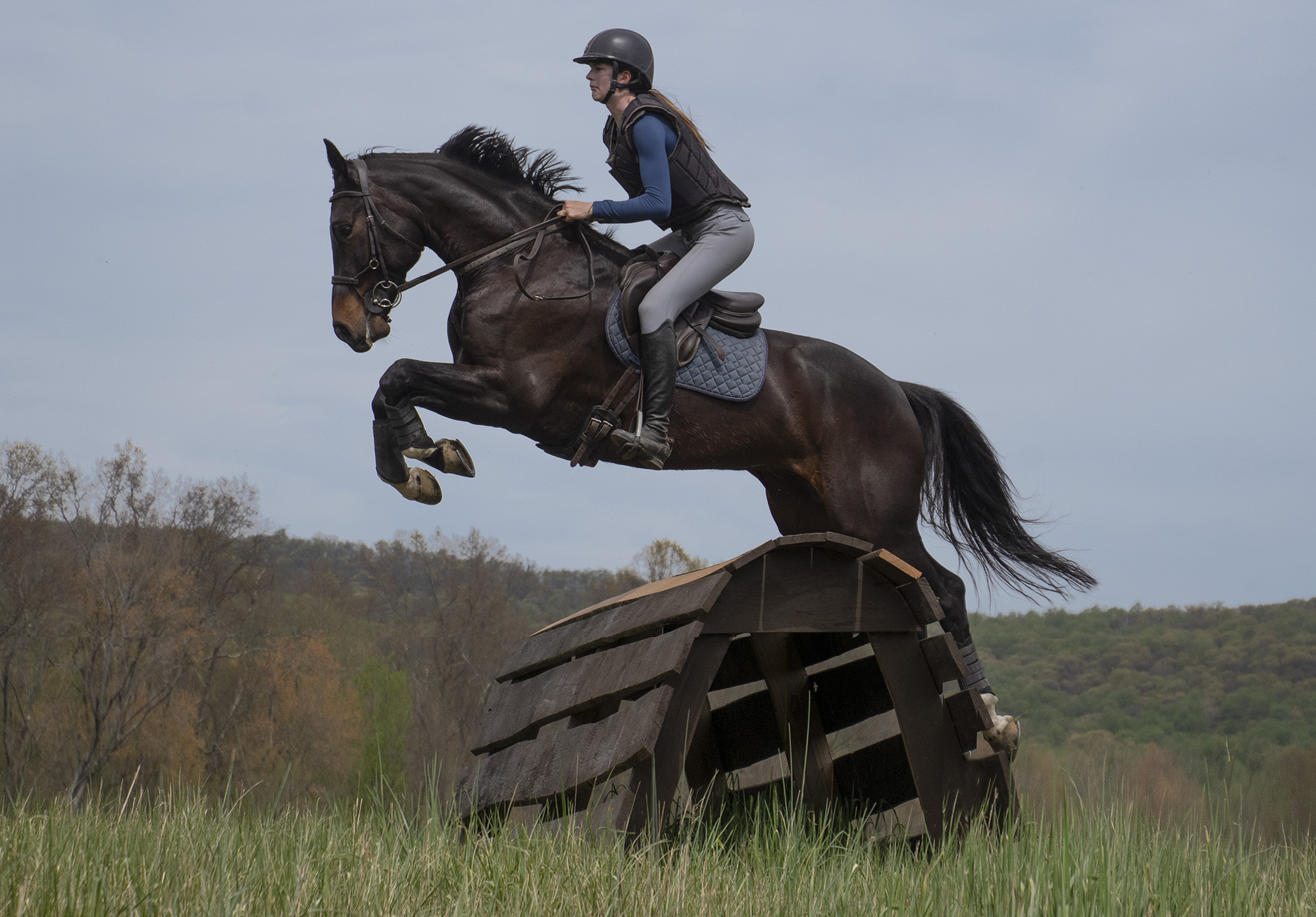Doug Payne tackles the topic of keyholes in his latest column for EN; Buck Davidson also contributed to this column. Many thanks to both Doug and Buck for writing. What do you think about keyholes on cross country, EN? Weigh in with your thoughts in the comments below.
 Laine Ashker's head makes contact with the keyhole on this year's Rolex Kentucky cross country course. Photo by Courtney Hyjek.
Laine Ashker's head makes contact with the keyhole on this year's Rolex Kentucky cross country course. Photo by Courtney Hyjek.
I am not alone in my disdain for keyholes on cross country. I’ve been contemplating writing this since a keyhole was featured as the last jump on the Plantation Field CIC2* and CIC3* a few years back. I was just one of the many who had a very awkward jump there, but frankly I was lucky; there were a number of falls and refusals.
This trend has continued over the past few years with smaller cutout holes and stiffer materials causing further rider and horse injuries and falls. I think a closer look is necessary for the welfare of our horses, riders and eventing as a sport. In the wake of William Fox-Pitt’s head injury, which occurred at a keyhole on the Le Lion d’Angers course last month, changes need to be made now.
I think it’s our responsibility as riders and trainers to continually ask what is gained and what is the goal of each question we ask of our horses on cross country. As course design evolves, horse and rider welfare should be paramount. I’m afraid it’s crossed a line when it comes to keyholes; horses and riders are paying the price for a cheap trick of a jump.
Over the past few years designers have begun to push the boundaries of keyhole design. The size of the lower jump, diameter of the hole, brush material stiffness, jump placement (relative to terrain and in combination with other obstacles) in which horse and rider are expected to jump through — all have become more restrictive and dangerous. I fail to see what benefit this trend offers the sport.
I think it’s important to keep in mind the goal of the cross country test. The FEI eventing rulebook defines essence of our sport this way:
The Cross Country Test constitutes the most exciting and challenging all-round test of riding ability and horsemanship where correct principles of training and riding are rewarded. This test focuses on the ability of Athletes and Horses to adapt to different and variable conditions of the Competition (weather, terrain, obstacles, footing, etc.) showing jumping skills, harmony, mutual confidence, and in general “good pictures.”
With that in mind, the keyhole jump is one which tends to be jumped well or not, purely based on the horse’s instinct alone. I personally have one built at our place that is placed over a show jump so that it can be infinitely adjusted. Nearly from day one, we take our horses through it — the babies with just a rail on the ground and the more experienced horses a larger effort.
Some horses could care less, while a majority of the others tend to duck their head and leave their front end as an afterthought. Their technique does tend to improve if jumped a number of times in a row on the day, but a horse that naturally jumps them poorly will always do so the first time out each day, making the approach on cross country a nerve-wracking one.
Why also should we encourage horses to jump lower and with inferior technique? Our goal in training should be to encourage better, safer jumping horses.

Doug Payne and Vandiver through the keyhole on this year’s Dutta Corp Fair Hill CCI3* course. Photo by Julianne Pettyman.
Making this type of jump even more perilous, the size of the hole has continued to decrease, and in many cases the material used has become stiffer. A tremendous number of riders, myself included countless times, have had their heads make contact with the top of the cutout. As the material becomes stiffer, the consequences and risk of this have become much more significant.
Adding to the likelihood of contact is the recent trend to use a keyhole in combination with other jumping efforts, along with using terrain to make them more difficult. If the keyhole is not the last element in a combination, riders are more apt to open their hip angle to be prepared to steer to the remaining efforts. As their shoulders come back, they either end up having to duck or make contact with the brush.
Endangering the rider’s head and neck is the price paid for properly preparing their horses for the remainder of the combination.
For some context, the FEI Cross Country Course Design Guidelines on keyholes are:
Hole fences
- The height of the hole should not be less than 1.80 m and the width not less then 1.60 m
- Any surface that can be touched by the Horse must always be soft (not susceptible to hurt the Horse or the athlete)
- The spread should not be more than 50% of that permitted for the level. The comment about double brushes (see above) applies.
Fences with roof
- The roof should not be placed at less than 2.20 m from the top of the fence.
- It is not recommended to use roods at water complex where the Horse has to jump into the roofed area (e.g. where there is a roofed bank in the water).
While these dimensions may seem acceptable, they are seldom adhered to. The most important aspect to keep in mind is that these are only guidelines rather than regulations. At the moment, any course designer can specify a hole the size of a beachball if he or she wanted.
Secondarily, the material used can make a dramatic difference when it comes to stiffness and safety. We are on borrowed time; without a change soon, we will have a rider suffer a head and neck injury while jumping through a keyhole.
At the moment, horses and riders heading out on course are being asked to jump through ever more dangerous keyhole jumps. As the hole size, material, placement and jump width become more difficult, I can’t help but highlight the hypocrisy.
The FEI guidelines read that keyholes must be made of materials “not susceptible to hurt the Horse or the Athlete,” but the FEI is failing our horses, our riders and our sport.
It’s time that keyhole jumps are greatly expanded in diameter and built with softer material upon a solid jump without width and without being an element of a combination or part of another element like a ditch or water. Safe passage for horse and rider is a must for our sport to continue to grow.
[FEI Cross Country Course Design Guidelines]












![IMG_3088[1]](https://assets.eventingnation.com/eventingnation.com/images/2015/11/IMG_308811-e1446660742358-640x209.png)
![IMG_3096[1]](https://assets.eventingnation.com/eventingnation.com/images/2015/11/IMG_30961-e1446660691739-640x255.png)
![IMG_3098[1]](https://assets.eventingnation.com/eventingnation.com/images/2015/11/IMG_30981-e1446661443496-640x194.png)

![IMG_3138[1]](https://assets.eventingnation.com/eventingnation.com/images/2015/11/IMG_31381-e1446661735288-640x518.png)
![IMG_3127[1]](https://assets.eventingnation.com/eventingnation.com/images/2015/11/IMG_31271-e1446662030508-640x451.png)
![IMG_3132[1]](https://assets.eventingnation.com/eventingnation.com/images/2015/11/IMG_31321-e1446661961766-640x297.png)
![IMG_3129[1]](https://assets.eventingnation.com/eventingnation.com/images/2015/11/IMG_31291-e1446662547136-640x354.png)
![IMG_3124[1]](https://assets.eventingnation.com/eventingnation.com/images/2015/11/IMG_31241-e1446663317987-640x361.png)
![IMG_3072[1]](https://assets.eventingnation.com/eventingnation.com/images/2015/11/IMG_30721-e1446666374366-640x104.png)






















